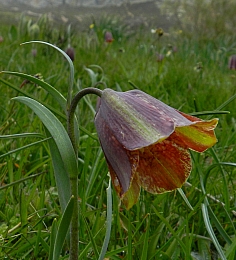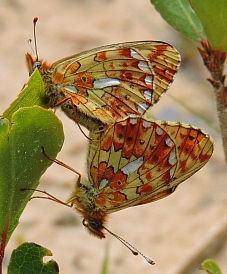 |
Picos de Europa:
a naturalist's paradise
- part 5
by Teresa Farino
Puerto de San Glorio
 Pyrenean Snakeshead
Pyrenean Snakeshead
Fritillaria pyrenaica
© Teresa Farino
This 1,609m pass on the N-621 essentially divides the Picos de Europa from the
neighbouring Cordillera Cantábrica. High-level haymeadows here house
acid-loving flowers such as common bistort, horned pansy, great yellow gentian, large
self-heal, Pedicularis mixta, Narcissus pseudonarcissus ssp. nobilis
and Pyrenean snakeshead, plus vanilla, pale-flowered, elder-flowered and frog
orchids. Slaty screes host Teesdaliopsis conferta and
Phalacrocarpum oppositifolium, both
unique to northern Iberia, while boggy areas are populated by aconite-leaved
 Pearl-bordered Fritillaries
Pearl-bordered Fritillaries
Boloria euphrosyne
© Teresa Farino
buttercup, hairy stonecrop, starry and yellow mountain saxifrages, water avens,
grass-of-Parnassus, snow gentian, large-flowered butterwort and white false
helleborine.
Pyrenean desmans are known from the many small streams of the San Glorio
area, while the surrounding forests are home to high densities of wildcat and
Eurasian badger. Wolf and brown bear are the most noteworthy mammals of the mountains
to the south of the pass, with red deer frequent in winter.
Whitethroats, red-backed shrikes and rock buntings occupy the scrub, as do
Cantabrican vipers, often sporting melanic coloration.
In terms of the butterflies, San Glorio is a
classic locality for Chapman's ringlet (endemic to the central Cordillera
Cantábrica) in June, along with marsh, pearl-bordered and Queen of Spain
fritillaries, with July bringing Apollo, Esper's marbled white, rock grayling
and purple-edged, purple-shot and scarce coppers.
Flora & Fauna of the Picos de Europa
Over the past 30 years, Teresa Farino has compiled a report (more than 100 A4 pages) that includes lists of all the mammals, birds, reptiles, amphibians, butterflies, dragonflies, beetles, grasshoppers & crickets, spiders and vascular plants ever recorded the Picos de Europa, plus an eight-page introduction to the natural history of these mountains. If you would like to purchase a PDF copy, the price is 12 € (or the sterling equivalent). Please contact Teresa for further details or to place your order.
|